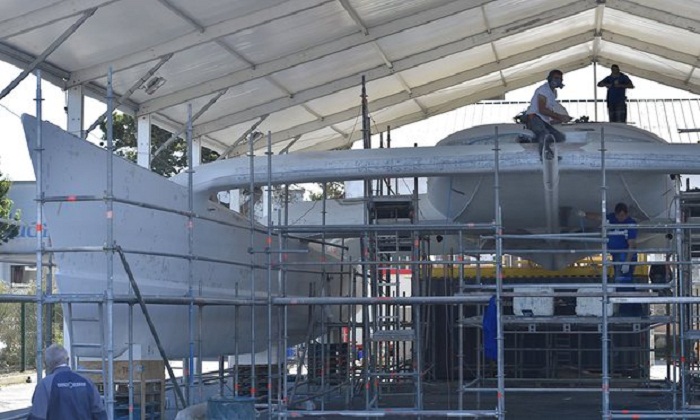The multi-hulled catamaran is in a shipyard at Saint Malo on France’s west coast, awaiting the installation of solar panels, wind turbines and electrolysis equipment, which breaks down water to produce its component elements, hydrogen and oxygen.
“We are going to be the first boat with an autonomous means of producing hydrogen,” says Frenchman Victorien Erussard, who is behind the project – confidential until now – with compatriot Jacques Delafosse, a documentary filmmaker and professional scuba diver.
The plan is for the boat’s batteries, which will feed the electric motors, to be powered in good weather by solar and wind energy, explained the 37-year-old merchant navy officer.
“If there’s no sun or wind, or if it’s night, stored hydrogen – generated by electrolysis powered by the solar panels and two wind turbines – will take over,” he said.
As a result, the vessel’s trip will not use any carbon-emitting fossil fuels, as is the case for 96% of boats today.
The vessel itself has a storied past.
The catamaran won the Jules Verne trophy for a team sailing non-stop round the world, in 1994. It was bought for €500,000 ($562,000) and extended by a whopping six metres, to 30.5 metres (100 feet), for the project.
One of the backers of the endeavour is well-known French environmentalist Nicolas Hulot.
“I support it because it’s the first project of this kind to actually be undertaken, it’s ambitious and looking toward the future,” Hulot, a former special envoy on environmental protection to President François Hollande, told AFP.
“It’s very promising for marine transport,” Hulot added. “The Energy Observer is going to demonstrate that you can have great autonomy (at sea) and you can store and find energy when there isn’t any more wind or sun.”
The Energy Observer was designed in partnership with a team of naval architects and the CEA-Liten research institute in the French city of Grenoble, which is dedicated to renewable energy technologies.
At a total cost of €4.2m ($4.72m), the green energy boat will be fitted with sensors to act as veritable moving laboratory for CEA-Liten, whose director Florence Lambert describes the project as a “great challenge”.
“Energy Observer is emblematic of what will be the energy networks of tomorrow, with solutions that could even be used within five years,” said Lambert.
“For example, the houses of tomorrow could incorporate a system of hydrogen storage, which is produced during the summer months and then used in the winter.”
The head of the project at CEA-Liten, Didier Bouix, adds that hydrogen can store “20 times more energy” than conventional batteries.
Energy Observer’s world tour is expected to take six years. After a careful crossing of the Mediterranean, the catamaran will venture out into the Atlantic and then Pacific oceans.
In all, 101 stopovers are planned from Cuba to New Caledonia to Goa on India’s west coast.
There are still hurdles to overcome, not least in funding: the Energy Observer’s trip is expected to cost a minimum of €4m a year, notably to develop a traveling exhibition.
But the team said it is confident of getting the funds.
And once again it finds inspiration from its airplane mentor Solar Impulse – which flew around the world on renewable energy and accomplished “what everyone said was impossible,” said Delafosse.
More about:
















































